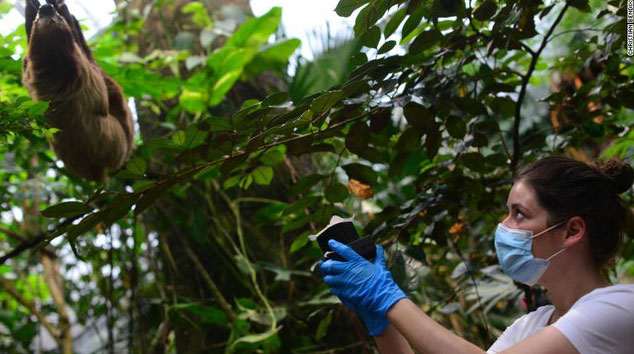International scientists in Denmark, the UK, and Canada have now been able to collect and analyze DNA—the molecule that contains genetic material and genes—extracted from the air.
All living organisms, including humans, “shed” genetic material DNA into the environment through waste excretion, bleeding, and shedding skin or fur. DNA exists in the environment in the form of saliva and dead cells. DNA released by living organisms into the environment is referred to as environmental DNA (eDNA).
In recent years, conservation scientists have sequenced DNA in water to monitor specific species, such as the great crested newt population in the UK, which lives in aquatic environments. However, collecting animal DNA from the air has only been researched recently.
This groundbreaking new technique is used to protect endangered animals and natural ecosystems, according to CNN.

Associate Professor Kristine Bohmann at the University of Copenhagen (Denmark) collecting air samples – (Photo: CNN).
All living organisms, including humans, “shed” DNA genetic material into the environment through waste excretion, bleeding, and shedding skin or fur.
Two independent research teams—one in Denmark and the other in the UK and Canada—examined whether DNA in the air could be used to detect different animal species. They collected samples at the Copenhagen Zoo in Denmark and the Hamerton Zoo Park in the UK.
Despite using different methods to filter DNA from the air, both teams successfully identified nearby animal species, including those within the zoo’s enclosures and outside. Their research findings were published in the journal Current Biology on January 6.
The lead author of the study in the UK, Elizabeth Clare, an assistant professor at York University in Canada, stated that the team working at Hamerton Zoo Park identified DNA from 25 different animal species, including tigers, lemurs, and dingoes.
Clare noted: “We were even able to collect DNA from animals hundreds of meters away from the testing site and even from completely sealed buildings, without a significant reduction in DNA concentration.”
The Copenhagen research team discovered 49 vertebrate species, including 30 mammal species.
Kristine Bohmann, an associate professor at the Globe Institute at the University of Copenhagen and the lead author of the study in Denmark, explained: “We were very surprised to obtain these results. In just 40 samples, we detected 49 species, including mammals, birds, amphibians, reptiles, and fish.
At Rainforest House (Copenhagen Zoo), we even detected guppies in the pond and two-toed sloths. When sampling air from just one outdoor location, we found many other animal species like ostriches and rhinoceroses.”
The Copenhagen research team used a fan to draw air from the zoo and its surroundings. From there, they extracted DNA and replicated it before sequencing to identify the animal species.
Both research teams also detected the presence of animal species not residing in the zoos, including the Eurasian hedgehog—which is endangered in the UK—found outside Hamerton Zoo. Meanwhile, the water monkey and red squirrel were identified around Copenhagen Zoo.
Scientists believe this technique could help them map species and eliminate the need for traps.
The non-invasive nature of this method is particularly valuable for observing vulnerable or endangered species and those in hard-to-reach environments, such as caves.
These DNA-related techniques also have significant implications in scientific research. Archaeologists are using DNA found in dust layers in caves to learn about ancient human populations.


















































